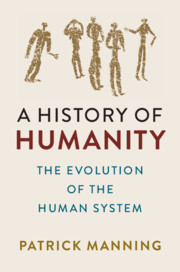Book contents
- A History of Humanity
- A History of Humanity
- Copyright page
- Contents
- Maps, Figures, and Tables
- Preface
- Acknowledgments
- Introduction
- Pleistocene Evolution
- 2 Biological and Cultural Evolution
- 3 Speech and Social Evolution
- 4 Systemic Expansion
- 5 Production and Confederation
- Holocene Evolution
- Anthropocene Evolution
- Appendix: Frameworks for Analysis
- Notes
- Glossary
- References
- Index
2 - Biological and Cultural Evolution
from Pleistocene Evolution
Published online by Cambridge University Press: 14 February 2020
- A History of Humanity
- A History of Humanity
- Copyright page
- Contents
- Maps, Figures, and Tables
- Preface
- Acknowledgments
- Introduction
- Pleistocene Evolution
- 2 Biological and Cultural Evolution
- 3 Speech and Social Evolution
- 4 Systemic Expansion
- 5 Production and Confederation
- Holocene Evolution
- Anthropocene Evolution
- Appendix: Frameworks for Analysis
- Notes
- Glossary
- References
- Index
Summary
This chapter traces evolution of hominin species from the late Pliocene era to 100,000 years ago, focusing on the concurrent emergence of several remarkable capabilities. The chapter begins with the biological evolution of the phenotype of succeeding species, including unusual growth in brain capacity. With the rise of Homo heidelbergensis some 700,000 years ago, this species and its offspring—especially Homo sapiens, Neanderthals, and Denisovans, gained capabilities including advances in learning (facilitated through inclusive fitness and multilevel selection), visual communication, logic, internal language, articulation of emotions, and family level behavior in groups of 15 to 30 individuals. The chapter traces documentation of these changes through studies in paleontology, cultural evolution, evolutionary linguistics, evolutionary psychology, and social anthropology; it defines the sum of these hominin capabilities as “individual-level human nature.” Such individual-level human nature allows for processes. The chapter concludes with the question of the degree to which these capabilities, known for Homo sapiens, also characterized Neanderthals and Denisovans.
- Type
- Chapter
- Information
- A History of HumanityThe Evolution of the Human System, pp. 19 - 35Publisher: Cambridge University PressPrint publication year: 2020

